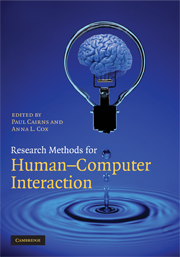Book contents
- Frontmatter
- Contents
- List of figures
- List of tables
- List of contributors
- Preface
- 1 Controlled experiments
- 2 Questionnaires, in-depth interviews and focus groups
- 3 Eyetracking in HCI
- 4 Cognitive modelling in HCI research
- 5 Formal analysis of interactive systems: opportunities and weaknesses
- 6 Using statistics in usability research
- 7 A qualitative approach to HCI research
- 8 Methodological development
- 9 Theoretical analysis and theory creation
- 10 Write now!
- 11 Applying old research methods to new problems
- References
- Index
8 - Methodological development
Published online by Cambridge University Press: 05 April 2016
- Frontmatter
- Contents
- List of figures
- List of tables
- List of contributors
- Preface
- 1 Controlled experiments
- 2 Questionnaires, in-depth interviews and focus groups
- 3 Eyetracking in HCI
- 4 Cognitive modelling in HCI research
- 5 Formal analysis of interactive systems: opportunities and weaknesses
- 6 Using statistics in usability research
- 7 A qualitative approach to HCI research
- 8 Methodological development
- 9 Theoretical analysis and theory creation
- 10 Write now!
- 11 Applying old research methods to new problems
- References
- Index
Summary
Overview
One feature of HCI research is that a broad range of methods have been developed to support the design and evaluation of interactive systems. In this chapter, we focus on evaluation methods – not because they are more important than design methods, but because we have more experience of them. In particular we consider the excitements and challenges of research on developing and testing new methods for evaluating interactive systems.
Evaluation methods can be broadly classed on three dimensions:
with or without the active involvement of users
with or without a running system
with or without a realistic context of use.
Most methods fit into one position in this three-dimensional space. For example, controlled experiments typically involve the active participation of users with a running system in a laboratory setting (a non-realistic context of use), while contextual inquiry (Beyer and Holtzblatt, 1998) involves users with a running system in a realistic context. Conversely, interviews involve users but typically not a running system (though they may sometimes take place within the intended context of use). Most of the techniques that involve the active participation of users have drawn on and adapted methods initially developed within the social sciences, and methodological development has been relatively minor and definitely incremental.
In this chapter we focus on the other set of methods – those which do not require the active involvement of users, being applied, rather, by HCI experts.
- Type
- Chapter
- Information
- Research Methods for Human-Computer Interaction , pp. 158 - 174Publisher: Cambridge University PressPrint publication year: 2008
- 1
- Cited by



